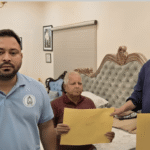On Thursday (24th July), the Hemant Soren government in Jharkhand stirred the hornet’s nest by renaming the Atal Mohalla Clinics as ‘Mother Teresa Advanced Health Clinics.’
For the unversed, Atal Mohalla Clinics are primary healthcare facilities that provide free and comprehensive healthcare services to people in the State.
They offer basic medical services like treatment for common diseases, basic lab tests, free medications and helped brige the gap in healthcare access.
VIDEO | Ranchi: BJP spokesperson Pratul Shah Deo (@pratulshahdeo) says, "Jharkhand govt's decision to rename Atal Mohalla Clinic as Mother Teresa Advance Health Clinics is unfortunate as there were allegations of conversion against Teresa's organisation."
(Full video available… pic.twitter.com/QQgsh1upTX— Press Trust of India (@PTI_News) July 24, 2025
The Hemant Soren government has now decided to rechristen the Atal Mohalla Clinics after the controversial Catholic nun, Mother Teresa.
“The Jharkhand Cabinet gave its approval to change the name of Atal Mohalla Clinic, being operated under the ongoing scheme under the State Plan, to Mother Teresa Advanced Health Clinic,” confirmed Cabinet Secretary Vandana Dadel.
The BJP has slammed the decision by the Hemant Soren government. Party spokesperson Pratul Shah Deo remarked, “You are removing the name of the person who helped create the State of Jharkhand and replacing it with that of Mother Teresa, whose organisation had been under the scanner for forced religious conversions and anti-constitutional activities.”
The truth about Mother Teresa
Mother Teresa established the ‘Missionaries of Charity’ in 1950. Within 2 years, she founded the ‘House of the Dying’ in Kalighat, Kolkata. The purpose was to take dying people off the streets and accommodate them in this facility.
When Dr Fox from the world-renowned medical journal, The Lancet, visited Mother Teresa’s Charity home in 1994, he was taken aback by the grim and deplorable conditions of the facility.
Medical negligence was rampant at the facility. Painkillers were seldom administered to the patients suffering in pain. Dr Fox narrated –
“On a short visit, I could not judge the power of their spiritual approach, but I was disturbed to learn that the formulary includes no strong analgesics. Along with the neglect of diagnosis, the lack of good analgesia marks Mother Teresa’s approach as clearly separate from the hospice movement. I know which I prefer.
Investigations, I was told, are seldom permissible. How about simple algorithms that might help the sisters and volunteers distinguish the curable from the incurable? Again no. Such systematic approaches are alien to the ethos of the home.“
And Mr Fox isn’t the only witness to harrowing tales of medical negligence in Mother Teresa’s ‘House of the Dying.’ Mary Loudon, who worked as a volunteer, narrated her experience in the 1994 documentary titled ‘Hell’s Angel‘.
She was stunned to know that the nuns reused the needles, injected into patients without even sterilising them. The nuns would simply wash the needles in cold water, a practice looked down upon in the medical world. Loudon also narrated the unfortunate story of a 15-year-old boy who was denied antibiotics after he had developed minor kidney complications.
In an unpublished Manuscript titled “Mother’s House”, Sushan Shields, who worked in the order of Mother Teresa for 9.5 years, narrated a shocking testimony.
“In the homes for the dying, Mother taught the sisters how to secretly baptize those who were dying. Sisters were to ask each person in danger of death if he wanted a ‘ticket to heaven’.An affirmative reply was to mean consent to baptism. The sister was then to pretend she was just cooling the person’s forehead with a wet cloth, while in fact she was baptizing him, saying quietly the necessary words. Secrecy was important so that it would not come to be known that Mother Teresa’s sisters were baptizing Hindus and Moslems.”
The extracts of her unpublished manuscript were produced in the book ‘The Missionary Position: Mother Teresa in Theory & Practice’ by Christopher Hitchens in 1995.
In 1992, Mother Teresa had herself admitted to converting 29000 people on their deathbeds to Christianity.
Mother Teresa’s ‘House for the Dying’ had not only shoddy, unhygienic conditions but was also the “House of Mass Conversions to Christianity.”
She had amassed enormous wealth collected in the form of donations and prize money of innumerable awards, the most significant one being the Nobel Peace Prize in 1979. Mother Teresa took money to help the poor of Calcutta, but primarily used the resources to expand her congregation in 105 countries.
She was a firm believer in “suffering in people as a means of reaching God.” This explains why poor patients (many of whom were suffering from terminal cancer) undergoing intense pain were denied painkillers. But Mother Teresa was a contradiction in herself.
Aroup Chatterjee writes in his book (Mother Teresa. The Untold Story), “Teresa always checked in to best hospitals when she was not well — 1996 in city’s Woodlands Clinic and Birla Heart Institute; earlier in Gemelli Hospital in Rome and Scripps Clinic in California.“
In June 2018, Mother Teresa’s Missionaries of Charity came under scrutiny for the sale of babies in Jharkhand’s capital city. Despite this, the Hemant Soren government has chosen to rename mohalla clinics after the controversial Catholic nun.













